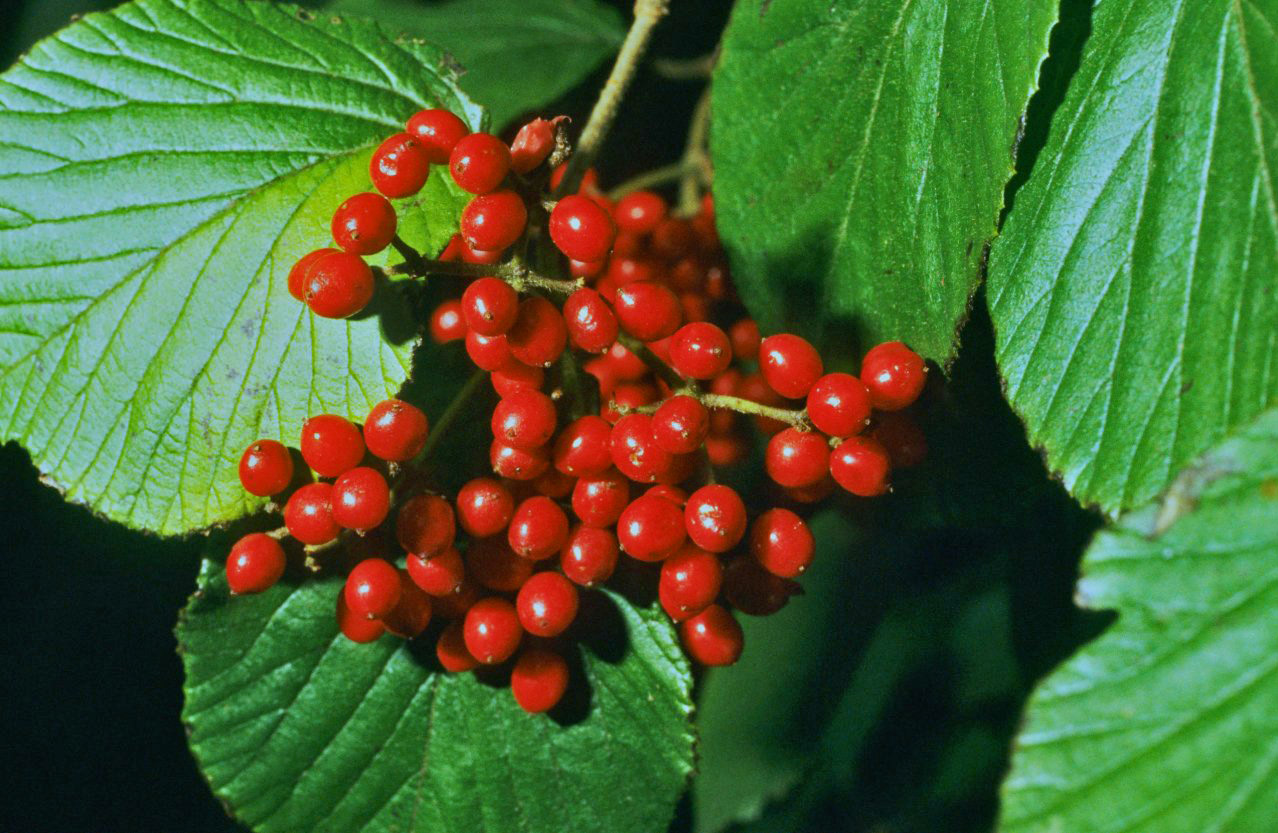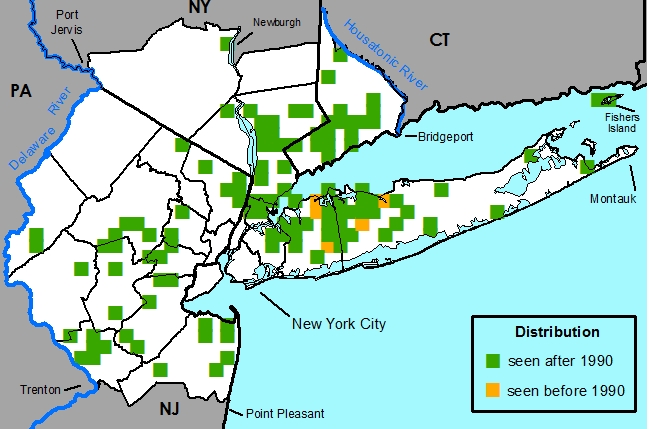Viburnum dilatatum Thunb. - Linden Viburnum
Common Names
Linden ViburnumField Identification
Shrub with opposite, toothed leaves, clusters of small white flowers followed by red berries.Other uses
Used as an ornamental in landscaping situations, hardy to USDA zone 5.
Nomenclature
Viburnum dilatatum Thunb., Fl. Jap. 124. 1784.Viburnum erosum sensu Gray in Perry, Narr. Exped. China Jap. 2: 313. 1856. not Thunb. 1784.
Viburnum dilatatum (var. nudiusculum) Gray, Mem. Am. Acad. Arts Sci. n. ser. 6: 393. 1859.
Viburnum sieboldii sensu Nakai, Saichu-to Kwanto Shokubutsu [Veg. Isl. Quelpaert], 84. 1914.
not Miquel 1866.
TYPE: unknown
*Viburnum dilatatum f. xanthocarpum Rehder, J. Arnold Arb. 3: 51. 1922.
TYPE: unknown
Description
HABIT Perennial, deciduous, phanerophytic, shrub, monoclinous, 1-3 m tall.STEMS Main stems ascending or erect, round. Bark smooth, not exfoliating, gray. Branches ascending. Twigs brown or light brown or gray, not odoriferous, terete, 1.5-4 mm in diam., smooth, with orange-red lenticels; glabrous or with long and unbranched hairs or with two to five-armed fasciculate-stellate hairs, erect or spreading, light brown or white, sparse or moderately dense or dense, distributed apically or at nodes, eglandular or glands sessile, orange-red or reddish orange; hairs sometimes restricted to current year twigs and nodes on 2nd year wood; glands, when present, restricted to current year twigs. Pith light brown or white, round, continuous, nodal diaphram absent. Sap translucent. For an expanded investigation of branch architecture see Yoda, 1993. For a detailed discussion of stem architecture see Donoghue, 1981. For a detailed analysis of the root anatomy see Gasson, 1979
BUDS Terminal and axillary present, scattered along stem; terminal bud ovoid, 4-5 mm long, pointed; axillary buds 1 per axil, ovoid, 2-3 mm long, pointed. Bud scales brown, membranaceous, with long and unbranched hairs, erect or spreading, light brown or white, moderately dense or dense, distrubted throughout, eglandular or glands sessile, orange-red or reddish orange. Leaf scars thinly crescent-shaped. Vascular bundle scars 3.
LEAVES Opposite, simple, spiral, 2 per node, spaced somewhat evenly along stem, divergent from stem. Stipules absent. Leaves petiolate, petiole furrowed, 0.5-2 cm long, with long and unbranched hairs or with two to five-armed fasciculate -stellate hairs. Not glabrescent, glands present, sessile, orange-red. Leaf blades: abaxial surface light green, adaxial surface green, elliptic or ovate or obovate or widely ovate or widely obovate, bilaterally symmetric, 3- 12 cm long, 2.5-9.5 cm wide, chartaceous, base cuneate or obtuse, margin toothed, dentate, apex acuminate or acute, abaxial surface with long and unbranched hairs or with two to five-armed fasciculate-stellate hairs, erect or appressed or spreading, light brown or white, moderately dense, distributed throughout. Glands present, sessile, orange-red or reddish orange or translucent. Adaxial surface with long and unbranched hairs or with two to five-armed fasciculate-stellate hairs, erect or appressed or spreading, light brown or white, moderately dense, distributed throughout, eglandular. Can be widely variable in shape and apex.
INFLORESCENCES Bisexual, compound, terminal, umbelliform cyme with unbranced and stellate hairs throughout and often with orange-red glands throughout. Peduncle 0.5-4 cm long. Bracts sessile, linear triangular, apex acute, caducous. Pedicels 0.5-1.5 mm long, with long and unbranched hairs or with tufted stellate hairs, hairs erect or spreading, light brown or white, sparse or moderately dense or dense, distributed throughout, glands present, sessile, orange-red or reddish orange. Bracteoles 0 or 1, at base of pedicel or at apex of pedicel, linear triangular, apex acute, caducous.
FLOWERS Formed on last season's growth, bisexual, with sepals and petals readily distinguishable from one another, 5- merous, fragrance absent, perianth of two whorls. Calyx actinomorphic, tubular, of fused sepals, persistent. Sepal lobes 5, very widely ovate, 0.5 mm long, 0.5 mm wide, margin ciliate, apex obtuse, abaxial surface glabrous, eglandular or glands sessile, orange-red or reddish orange. Corolla actinomorphic, acetabuliform, of fused petals, deciduous, abaxial and adaxial surfaces the same color, white, 5-6 mm wide. Petal lobes 5, widely ovate, 1.5-2 mm long, 1.5-2 mm wide, margin entire, apex obtuse, abaxial surface with long and unbranched hairs, glands sessile or absent, adaxial surface glabrous, eglandular, margins minutely papillose. Gynoecium syncarpous. Carpels 1. Locules 3, 2 abortive, 1 fertile. Stigmas 1, 3-lobed on a short stylopodium at the top of the ovary. Styles 1, short, conical, glabrous. Ovary inferior, glabrous, eglandular. Placentation axile or parietal. Androecium alternate, epipetalous, exserted, haplostemous. Stamens 5. Anthers light red, glabrous, eglandular. Filaments white, glabrous, adnate to base of petals. For a morphological analysis of pollen see Donoghue, 1985.
FRUITS Drupe, orange-red (f. xanthocarpum yellow-fruited), ovoid, 6-8 mm long, 5 mm wide, glabrous, eglandular.
SEEDS Seeds 1, light yellow, lenticular, 5-6 mm long, 4.5-5 mm wide, glabrous, eglandular, pusticulate.
Habitat
Usually found in mesic woods with moderately to well-drained substrates.Distribution
Indigenous to East Asia, becoming naturalized in the eastern United States.United States -- CT, DE, IL, MD, NJ, NY, PA, VA
New York Metropolitan Region -- Nonnative, escaping from cultivation throughout the metropolitan region, especially near the coast.
Rarity Status
Heritage Global Rank -- G5Species Biology
Flowering May [week 3] - June [week 3]Pollination
Mycophily -- Temnostoma spp.
Fruiting June [week 4] - September [week 4]
Dispersal
Ridley, 1930 Martin,, 1951 (White, 1992)
Probably Endozoochory -- via Avian frugivores: Pinicola enucleator (Pine Grosbeak), Acanthis flammea (Redpoll), Cardinalis cardinalis (Cardinal), Vireo olivaceus (Red-eyed Vireo), Bonasa umbellus (Ruffed Grouse), Phasianus colchicus (Ring-necked Pheasant), Meleagris gallopava (Turkey), Turdus migratorius (Robin), Sturnus vulgaris (Starling), Catharus minimus (Gray-cheeked Thrush), Catharus guttata (Hermit Thrush), Catharus ustulata (Olive- backed Thrush), Myiarchus crinitus (Great Crested Flycatcher), Bombycilla cedrorum (Cedar waxwing), Dryocopus pileatus (Pileated Woodpecker),
Mammals: Peromyscus spp. (White-footed Mice), Tamias striatus (Chipmunk), Euarctos americanus (Black Bear), Vulpes fulva (Red Fox), Sciurus carolinensis (Eastern Gray Squirrel), Sciurus niger (Eastern Fox Squirrel), Sylvilagus floridanus (Cottontail Rabbit), Mephitis mephitis (Skunk)
Germination
Schopmeyer, 1974 Giersbach, 1937 Fedec, 1973
Viburnum seed is slow to germinate and most species have embryo dormancy as well as seedling (epicotyl) dormancy and hard seed coats. Stratification at a constant 20 degrees C or a daily alternating temperature of 20 to 30 degrees C for germination followed by a low temperature pre-treatment for seedling production generally gives the best results. Seedling dormancy might be overcome by removal of the cotyledons or by a treatment of gibberellic acid (GA3).
Stratification for 6-8 months at a constant 20 degrees C or a daily alternating temperature of 20 to 30 degrees C in moist soil or peat has given the good results. Germination is epigeous. Seed can probably be stored in a sealed container at 41 degrees F with little loss of viability after one to two years.
Dried seeds can be stored at low temperature for several years. Young, 1992

